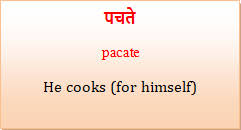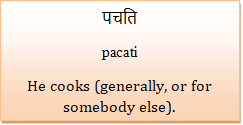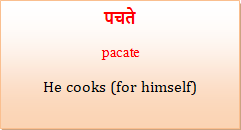We earlier studied that verbs are of two types; Parasmaipada and atmanepada. Parasmaipada words usually describe the activity done by others or result occurring to others, for instance, “he feels happy”. However, we will learn about Parasmaipada in detail further. Here we are going to learn about the word atmanepada. Atmanepada, contrary to the former one is a self-serving one. Here the verb describes the activity done by itself or result occurring to the self, for instance, “I feel happy”
पचति
pacati
He cooks (generally, or for somebody else).
पचते
pacate
He cooks (for himself)
Atmanepada normally ends with “te” in the end
Some scholars have perhaps, underrated and questioned the use of atmanepada in the Sanskrit language, as most of the verbs are Parasmaipada. This is partially true, as we agree that Parasmaipada is extensively used but that does not deny the importance of atmanepada verbs.
Apart from their endings, both Parasmaipada, and atmanepada exhibit same behavior, both are classified into ten classes. Hence, the only factor that distinguishes them is the endings.
So let us take a look at each of the verb in present tense form.
Singular Dual Plural
Third person लभते
labhate
लभन्ते
labhante
Second person लभसे
labhase
First person लभे
labhe
लभावहे
labhāvahe
लभामहे
labhāmahe
Now let us compare it to the Parasmaipada verb
गम् Singular Dual Plural
Third person गच्छति
gacchati
गच्छन्ति
gacchanti
Second person गच्छसि
gacchasi
First person गच्छामि
gacchāmi
गच्छावः
gacchāvaḥ
गच्छामः
gacchāmaḥ
Notice that only 1st person singular has changed, rest all are quite similar to each other.





